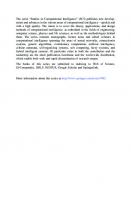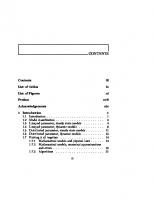Using Computational Methods to Teach Chemical Principles 0841234205, 9780841234208
While computational chemistry methods are usually a research topic of their own, even in the undergraduate curriculum, m
267 99 28MB
English Pages 288 [278] Year 2020
Table of contents :
Foreword
Contents
1 Using Computational Methods To Teach Chemical Principles: Overview
2 Molecular Dynamics Simulations in First-Semester General Chemistry: Visualizing Gas Particle Motion and Making Connections to Mathematical Gas Law Relationships
3 Using Electronic Structure Calculations To Investigate the Kinetics of Gas-Phase Ammonia Synthesis
4 Modeling Reaction Energies and Exploring Noble Gas Chemistry in the Physical Chemistry Laboratory
5 How Can You Measure a Reaction Enthalpy without Going into the Lab?
6 Process Oriented Guided Inquiry Learning Computational Chemistry Experiments: Revisions and Extensions Based on Lessons Learned from Implementation
7 Chem Compute Science Gateway: An Online Computational Chemistry Tool
8 Using Computational Chemistry to Extend the Acetylene Rovibrational Spectrum to C2T2
9 Introducing Quantum Calculations into the Physical Chemistry Laboratory
10 Learning by Computing: A First Year Honors Chemistry Curriculum
11 Integrating Computational Chemistry into an Organic Chemistry Laboratory Curriculum Using WebMO
12 Computational Narrative Activities: Combining Computing,Context, and Communication To Teach Chemical Concepts
13 Computational Chemistry as a Course for Students Majoring in the Sciences
14 Beyond the Analytical Solution: Using Mathematical Software To Enhance Understanding of Physical Chemistry
15 A Lab Course in Computational Chemistry Is Not About Computers
16 Discovery-Based Computational Activities in theUndergraduate Chemistry Curriculum
17 Using the Hydrogen Bond as a Platform for the Enhancement of Integrative Learning
Editors’ Biographies
Author Index
Subject Index
Foreword
Contents
1 Using Computational Methods To Teach Chemical Principles: Overview
2 Molecular Dynamics Simulations in First-Semester General Chemistry: Visualizing Gas Particle Motion and Making Connections to Mathematical Gas Law Relationships
3 Using Electronic Structure Calculations To Investigate the Kinetics of Gas-Phase Ammonia Synthesis
4 Modeling Reaction Energies and Exploring Noble Gas Chemistry in the Physical Chemistry Laboratory
5 How Can You Measure a Reaction Enthalpy without Going into the Lab?
6 Process Oriented Guided Inquiry Learning Computational Chemistry Experiments: Revisions and Extensions Based on Lessons Learned from Implementation
7 Chem Compute Science Gateway: An Online Computational Chemistry Tool
8 Using Computational Chemistry to Extend the Acetylene Rovibrational Spectrum to C2T2
9 Introducing Quantum Calculations into the Physical Chemistry Laboratory
10 Learning by Computing: A First Year Honors Chemistry Curriculum
11 Integrating Computational Chemistry into an Organic Chemistry Laboratory Curriculum Using WebMO
12 Computational Narrative Activities: Combining Computing,Context, and Communication To Teach Chemical Concepts
13 Computational Chemistry as a Course for Students Majoring in the Sciences
14 Beyond the Analytical Solution: Using Mathematical Software To Enhance Understanding of Physical Chemistry
15 A Lab Course in Computational Chemistry Is Not About Computers
16 Discovery-Based Computational Activities in theUndergraduate Chemistry Curriculum
17 Using the Hydrogen Bond as a Platform for the Enhancement of Integrative Learning
Editors’ Biographies
Author Index
Subject Index





![Computational methods in chemical engineering with Maple [1 ed.]
9783642043109, 3642043100](https://ebin.pub/img/200x200/computational-methods-in-chemical-engineering-with-maple-1nbsped-9783642043109-3642043100.jpg)

![Computational Methods in Chemical Engineering with Maple [1 ed.]
3642043100, 9783642043109](https://ebin.pub/img/200x200/computational-methods-in-chemical-engineering-with-maple-1nbsped-3642043100-9783642043109.jpg)
![Advances in Chemical Physics, Computational Methods for Protein Folding [1 ed.]
0471209554, 9780471209553, 9780471465232](https://ebin.pub/img/200x200/advances-in-chemical-physics-computational-methods-for-protein-folding-1nbsped-0471209554-9780471209553-9780471465232.jpg)

